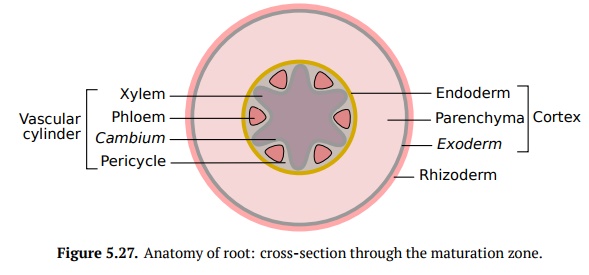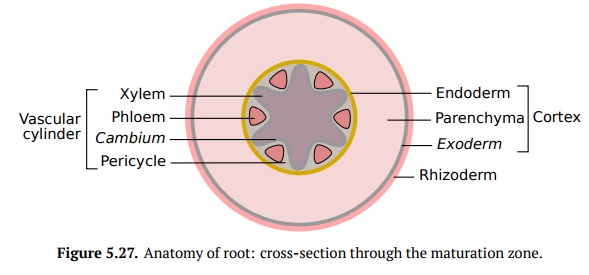Chapter: Introduction to Botany: Tissues and organs; How the Plant is built
Anatomy of the Root

Anatomy of the Root
On the longitudinal section of young growing
root, there are different horizontal layers, zones: root cap covering division zone, elongation zone, absorption
zone, and maturation zone (Fig. 5.25). The root
cap protects the root apical meristem (RAM), which is a group of small
regularly shaped cells. A small, centrally located part of the RAM is the quiescent center where initial cells
divide and produce all other cells of root. Root cap is responsible for the
geotropic growth, if the root tip comes into contact with a barrier, root cap
will feel it and will grow on a different direction to go around it.

The elongation zone is where the cells
start to elongate, giving it length. The absorption
zone is where the rhizodermis tissue (root hairs) develops and wherewater
and nutrients are absorbed and brought into the plant. Within the matu-ration zone, root hairs degrade,
many cells start to acquire secondary walls andlateral roots develop (Fig. 5.25).
On the cross-section of the root made within
absorption zone, the first tissue is the rhizodermis, which is also known as
the root epidermis, then cortex, which segregates external exodermis and internal endodermis
one-cellular layers, and vascular cylinder (Fig. 5.26).
Typically, roots have no pith. In some cases (for example, in orchids), cortex
may give multi-layered velamen (see
above), another absorption tissue.

Vascular cylinder is
located in the center of the root, it contains the pericycle which is made of
mostly parenchyma and bordering endodermis. Pericycle cells may be used for
storage, they contribute to the vascular cambium, and initi-ate the development
of lateral roots (consequently, lateral roots are develop-ing endogenously and
break tissues located outside). Root phloem is arranged in several strands
whereas xylem typically has a radial, sometimes star-shaped structure with few
rays (Fig. 5.27). In the last case, phloem
strands are located between rays of xylem.

Root tissues develop
in the way similar to stem, RAM gave rise to ground meris-tem, procambium, and
the protoderm, which in turn make all primary tissues mentioned above. Later,
pericycle develops into lateral roots or the vascular cambium which in turn
produces into the secondary xylem and phloem. The secondary root is similar to
secondary stem.
Related Topics